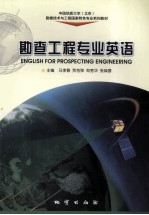图书介绍
勘查工程专业英语pdf电子书版本下载

- 马孝春等主编 著
- 出版社: 北京:地质出版社
- ISBN:9787116068513
- 出版时间:2010
- 标注页数:216页
- 文件大小:38MB
- 文件页数:227页
- 主题词:地质勘探-英语-教材
PDF下载
下载说明
勘查工程专业英语PDF格式电子书版下载
下载的文件为RAR压缩包。需要使用解压软件进行解压得到PDF格式图书。建议使用BT下载工具Free Download Manager进行下载,简称FDM(免费,没有广告,支持多平台)。本站资源全部打包为BT种子。所以需要使用专业的BT下载软件进行下载。如 BitComet qBittorrent uTorrent等BT下载工具。迅雷目前由于本站不是热门资源。不推荐使用!后期资源热门了。安装了迅雷也可以迅雷进行下载!
(文件页数 要大于 标注页数,上中下等多册电子书除外)
注意:本站所有压缩包均有解压码: 点击下载压缩包解压工具
图书目录
Unit 1 Chemical and Physical Properties of Rocks 1
1.1 Composition of Rocks 1
1.2 Geological Classification of Rocks 3
Unit 2 Soil Composition and Classification 9
2.1 Soil Composition 9
2.1.1 Weight-volume Relationships 10
2.1.2 Relative Density 11
2.1.3 Particle Size 12
2.1.4 Clays 12
2.1.5 Plasticity and the Atterberg Limits 13
2.2 Soil Classification 14
Unit 3 Influence of Groundwater to Engineering 19
3.1 Pavements 21
3.2 Slopes 22
Unit 4 Site Investigation 26
4.1 Background Literature Search 27
4.2 Field Reconnaissance 28
4.3 Subsurface Exploration and Sampling 28
4.4 Exploratory Borings 28
4.5 Soil Sampling 30
4.6 Groundwater Monitoring 30
4.7 Exploratory Trenches 31
Unit 5 Laboratory Testing of Soils 35
5.1 Introduction 35
5.2 Common Laboratory Tests 36
5.2.1 Index Tests 37
5.2.2 Oedometer 38
5.2.3 Shear Strength Tests 39
5.2.4 Permeability 43
Unit 6 In-situ Testing 47
6.1 Standard Penetration Test(SPT) 47
6.2 Cone Penetration Test(CPT) 49
6.3 Vane Shear Test(VST) 51
6.4 Pressuremeter Test(PMT) 52
6.5 Dilatometer Test(DMT) 52
6.6 Becker Penetration Test 53
6.7 Comparison of In-situ Test Methods 54
Unit 7 Drilling Technology 58
7.1 Classification of Types of Drilling 58
7.2 The Connection to the Bit 58
7.2.1 Transmission of Power 58
7.2.2 Control of the Bit 58
7.2.3 Conduct of Fluid 59
7.2.4 Conduct of Cuttings 59
7.2.5 Drill String Flexibility 60
7.2.6 Tasks Performed Down the Hole 60
7.2.7 The Drill String Gives the Clues 60
7.3 Pipes and Pipe Threads 61
7.3.1 Tubing for Drill Pipe 62
7.3.2 Tubing for Casing 62
7.3.3 Threads 63
7.3.4 Rotary Tool Joints 63
7.3.5 Drill Pipe Failure 64
7.3.6 Correct Make-up Torque 64
7.3.7 Caring for Pipes and Threads 65
7.4 Cable Tool and Hydraulic Drilling 65
7.4.1 Features of Cable Tool Percussion 65
7.4.2 Cable Tool Techniques 68
7.4.3 Other Cable Types 68
7.4.4 Hydraulic Types ofDrilling 69
7.4.5 Suitability of Hydraulic Drilling 70
7.4.6 Essential Cable Tool Drill String Components 71
7.5 Auger Drilling 71
7.5.1 Types of Auger Drilling 71
7.5.2 Applications of Auger Drills 72
7.6 Rotary and Down-hole Hammer Drilling 74
7.6.1 What is Rotary Drilling? 74
7.6.2 Forms of Rotary Drive 75
7.6.3 Methods of Feeding the Bit 75
7.6.4 Rotary Down-hole Hammer Drilling 77
7.6.5 Rotary Fluid Circulation 77
7.6.6 Reverse Circulation 78
7.6.7 Types and Features of Rotary Rigs 79
7.7 Slim-hole Rotary and Diamond Drilling 79
7.7.1 What is Meant by Slim-hole Rotary Drilling? 79
7.7.2 Varieties of Slim-hole Core Drilling 80
7.7.3 Diamond Drill Rigs 80
7.7.4 Other Slim-hole Types of Drilling 81
7.8 Drill Rig Parameters 82
Unit 8 Shallow Foundations 89
8.1 Function of Foundations 89
8.1.1 Foundation Engineering 89
8.1.2 Foundation Classification and Selection 91
8.1.3 General Requirements 92
8.1.4 Additional Considerations 93
8.2 Types of Shallow Foundations 94
8.2.1 Introduction 94
8.2.2 Strip Foundations 95
8.2.3 Rafts 97
Unit 9 Deep Foundations 99
9.1 Pile Foundations 99
9.1.1 Steel Piles 100
9.1.2 Concrete Piles 101
9.1.3 Negative Skin Frietion 101
9.1.4 Determination of Negative Skin Friction 102
9.1.5 Pile Groups 103
9.1.6 Pile Spacing 103
9.1.7 Efficiency 104
9.2 Drilled Shaft and Caisson Foundations 105
9.2.1 Types of Drilled Shafts 106
9.2.2 Construction Procedures 107
9.2.3 Types of Caissons 109
Unit 10 Soil Improvements 112
10.1 Methods of Soil Improvements 112
10.1.1 General Principles of Compaction 112
10.1.2 Vibroflotation 114
10.1.3 Sand Drains 115
10.1.4 Lime Stabilization 116
10.1.5 Cement Stabilization 118
10.1.6 Fly Ash Stabilization 119
10.1.7 Stone Columns 119
10.1.8 Sand Compaction Piles 120
10.1.9 Dynamic Compaction 121
10.2 Soil Stabilization 121
Unit 11 Grouting Engineering 128
11.1 Definition 128
11.2 Conceptual Design 128
11.3 Uses of Grouting 129
11.4 Types of Grouting 129
11.5 Assessment of Groutability 131
11.6 Impediments to Effective Grouting 131
11.6.1 Environmental Impact Assessment 132
11.6.2 Spoil and Waste Disposal 133
11.6.3 Site Health and Safety 134
Unit 12 Analyses of Bearing Capacity and Settlement of Structures 136
12.1 Bearing Capacity Failures 136
12.2 Settlement of Structures 141
12.2.1 Introduction 141
12.2.2 Allowable Settlement 143
12.2.3 Collapsible Soil 146
Unit 13 Retaining Structures 150
13.1 Soil Nailing 150
13.2 Landslides 155
Unit 14 Petroleum Drilling 162
14.1 Rotary Drilling 163
14.2 Circulation Systems 165
14.2.1 Direct Circulation 166
14.2.2 Reverse Circulation 167
14.3 Comparison of Mud and Air Drilling 169
14.3.1 Advantages and Disadvantages 169
14.3.2 Flow Characteristics 170
Unit 15 Trenchless Engineering 180
15.1 Horizontal Directional Drilling 180
15.1.1 Overview 180
15.1.2 Methods 181
15.1.3 HDD Drilling Machines 182
15.1.4 Fluid-assisted Boring 183
15.1.5 Fluid Jet Boring 184
15.1.6 Dry Boring 185
15.1.7 Drill Pipes 186
15.1.8 Drilling Fluids 186
15.1.9 Tracking&Guidance Systems 187
15.1.10 Ancillary Equipment 189
15.1.11 Latest Developments 189
15.1.12 Summary 190
15.2 Pipe Jacking and Microtunnelling 191
15.2.1 Overview 191
15.2.2 Applications 192
15.2.3 Excavation and Spoil Removal in Pipe Jacking 192
15.2.4 Excavation and Spoil Removal in Microtunnelling 193
15.2.5 Excavation and Spoil Removal in Pilot Auger Microtunnelling 194
15.2.6 Jacking Frames 194
15.2.7 Interjacks 195
15.2.8 Ground Conditions 195
15.2.9 Planning 195
15.2.10 Pipes 196
15.2.11 Shafts 197
15.2.12 Summary 198
附录A Introduction to CUGB 203
附录B 希腊字母 215
附录C 符号的读法 215
参考文献 216